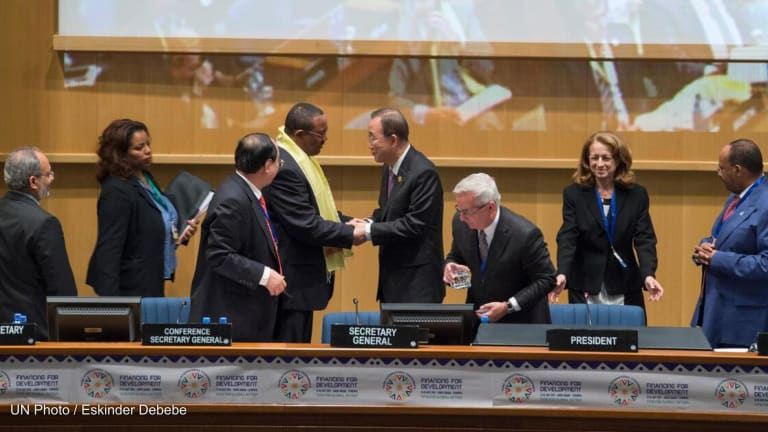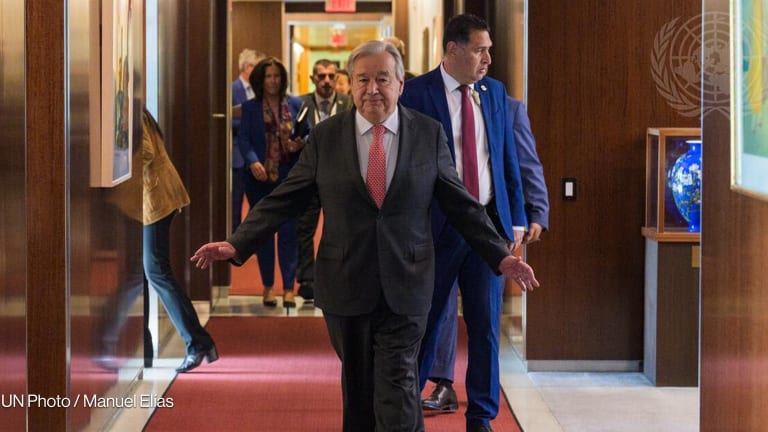Where do the world's extreme poor live?
Most of the world’s extreme poor — or those who subsist on less than $1.25 a day — live in five countries. But according to the World Bank, effective poverty reduction involves going beyond these five countries to target smaller countries with much higher percentages of poor populations.
The fight against global poverty is often illustrated in numbers. In 1990, 36 percent of the world’s population, or around 1.9 billion people, lived in extreme poverty. In 2010, that figure was slashed to slightly under 18 percent, or about 1.2 billion people. For 2020, the World Bank has set a target of reducing extreme poverty — a condition that the World Bank Group defines as living on less than $1.25 a day — to 9 percent. Even if the World Bank achieves its goal, it will still leave 690 million people — or more than half the population of China — living in extreme poverty. The 9 percent goal is an interim target that is part of the World Bank’s 2030 two-fold commitment: reduce the world’s extreme poor to no more than 3 percent of the global population, and promote income growth among the world’s bottom 40 percent. “Prosperity for All: Ending Extreme Poverty,” a paper prepared for last week’s spring meetings of the World Bank and the International Monetary Fund, notes that close to two-thirds of the world’s extreme poor are concentrated in five countries: India (33 percent), China (13 percent), Nigeria (7 percent), Bangladesh (6 percent) and the Democratic Republic of the Congo (5 percent). That India and China — two of the world’s most populous and fastest emerging countries — are included on the list shows that economic growth, while indispensable in reducing extreme poverty, does not always translate into improved living standards for the poor. In addition to the five countries, the world’s extreme poor are also living in Indonesia (4 percent), Pakistan (3 percent), Tanzania (3 percent), Ethiopia (2 percent) and Kenya (1 percent). Together, these 10 countries are home to 77 percent of the world’s most destitute people. While working to improve the lives of the extreme poor in these 10 countries is crucial to the goal of effectively ending extreme poverty by 2030, the World Bank paper cautiously notes that there are several smaller countries with even larger percentages of people living below the poverty line. According to the World Bank, these smaller countries should not be overlooked while the global development community crafts anti-poverty policies. For instance, there are 27 countries where people living in extreme poverty comprise at least 40 percent of the population — and 26 of these are in sub-Saharan Africa. The poverty headcount in Liberia, Burundi, Madagascar and Zambia, for example, ranges from 70 to 80 percent of the population. Providing the poor with opportunities to develop their potential is not just a moral obligation, it is also good economics. --— “Prosperity for All: Ending Extreme Poverty,” a World Bank Group paper The World Bank stresses that job creation, education and health interventions, and social protection programs targeting the poor are critical to ensure that those who are no longer part of the world’s extreme poor don’t fall back into poverty. Two examples from sub-Saharan Africa are highlighted in the paper. One is Liberia’s cash-for-works temporary employment program, which is now integrated into the country’s social protection system. The World Bank-supported program, which started as a response to the 2008 food price crisis, provided jobs to more than 17,000 beneficiaries before it was mainstreamed. Another is Ethiopia’s Productive Safety Net Program, which has reduced food insecurity for 8 million people in poor rural households. The program blunted the impact of the 2011 Horn of Africa crisis for Ethiopians, as it was scaled up to more than 11 million people during the widespread drought. Join the Devex community and gain access to more in-depth analysis, breaking news and business advice — and a host of other services — on international development, humanitarian aid and global health.
The fight against global poverty is often illustrated in numbers.
In 1990, 36 percent of the world’s population, or around 1.9 billion people, lived in extreme poverty. In 2010, that figure was slashed to slightly under 18 percent, or about 1.2 billion people.
For 2020, the World Bank has set a target of reducing extreme poverty — a condition that the World Bank Group defines as living on less than $1.25 a day — to 9 percent.
This story is forDevex Promembers
Unlock this story now with a 15-day free trial of Devex Pro.
With a Devex Pro subscription you'll get access to deeper analysis and exclusive insights from our reporters and analysts.
Start my free trialRequest a group subscription Printing articles to share with others is a breach of our terms and conditions and copyright policy. Please use the sharing options on the left side of the article. Devex Pro members may share up to 10 articles per month using the Pro share tool ( ).
Anna Patricia Valerio is a former Manila-based development analyst who focused on writing innovative, in-the-know content for senior executives in the international development community. Before joining Devex, Patricia wrote and edited business, technology and health stories for BusinessWorld, a Manila-based business newspaper.








